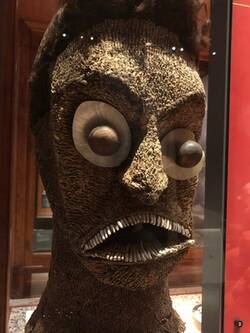Further Media
Producer unknown to us
Oceania, Polynesia, Hawai'i
Before 1781
Aerial roots of a climbing plant, coconut fiber, mother-of-pearl, wood, remains of red, yellow, black and white feathers
Acquired in 1773–74 or 1777 on Captain James Cook’s second or third expedition in the Pacific. It is yet unknown by whom the object was acquired.
Brought from Great Britain to Germany by Benjamin La Trobe, a Moravian working in London.
Inv. no. 68675
At the time of Cook’s travels some 250 years ago, mother-of-pearl eye disks completed the most important religious regalia on Hawai'i, the feather image of the mighty war god Kuka'ilimoku – translated as “the one who conquers the land.” The Herrnhut Cook collection contains one such dazzling mother-of-pearl disk and two of the woven circular supports used to attach the divine pair of eyes.
The object was probably acquired in an unfinished state because the transfer of mana – the divine energy of the ancestors – to the most powerful Hawai'ian deity was strictly kapu, i.e., forbidden under penalty of death. However, it is likely that individual parts of the feather image were considered objects of trade and exchange, especially prior to consecration by the Hawai'ian high priest.
It is also possible that the eyepieces were given as gifts to Captain Cook and his crew. When the two British ships anchored in Kealakekua Bay on Hawai'i (Big Island) on January 17th 1779, the locals regarded the British captain as a glorious returning ancestor god, Lono-i-ka-Makahiki, and celebrated him accordingly. “The shouts of joy, … women dancing and clapping their hands, the overseting of canoes, cries of children, goods on float … formed one of the most tumultuous and the most curious prospects that can be imagined” noted Marine John Ledyard, who accompanied Cook to Hawai'i at his landing.
Thus, Cook and his crew had a reception worthy of gods and were showered with gifts, including objects of high spiritual value.
